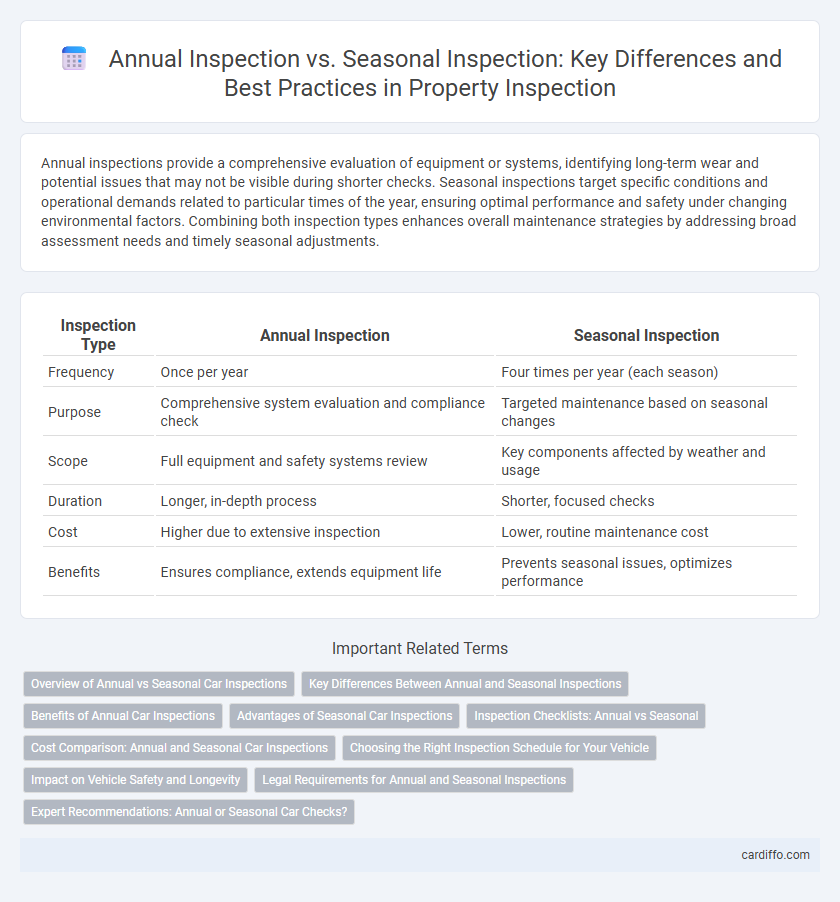Annual inspections provide a comprehensive evaluation of equipment or systems, identifying long-term wear and potential issues that may not be visible during shorter checks. Seasonal inspections target specific conditions and operational demands related to particular times of the year, ensuring optimal performance and safety under changing environmental factors. Combining both inspection types enhances overall maintenance strategies by addressing broad assessment needs and timely seasonal adjustments.
Table of Comparison
| Inspection Type | Annual Inspection | Seasonal Inspection |
|---|---|---|
| Frequency | Once per year | Four times per year (each season) |
| Purpose | Comprehensive system evaluation and compliance check | Targeted maintenance based on seasonal changes |
| Scope | Full equipment and safety systems review | Key components affected by weather and usage |
| Duration | Longer, in-depth process | Shorter, focused checks |
| Cost | Higher due to extensive inspection | Lower, routine maintenance cost |
| Benefits | Ensures compliance, extends equipment life | Prevents seasonal issues, optimizes performance |
Overview of Annual vs Seasonal Car Inspections
Annual car inspections provide a comprehensive evaluation of a vehicle's overall condition, covering critical systems such as brakes, emissions, engine performance, and safety features to ensure long-term reliability and compliance with state regulations. Seasonal inspections focus on specific components affected by weather changes, like tire tread depth, coolant levels, and windshield wiper functionality, optimizing vehicle safety and performance for winter or summer driving conditions. While annual inspections serve as a thorough preventive maintenance check, seasonal inspections address immediate environmental challenges to enhance safety and vehicle longevity.
Key Differences Between Annual and Seasonal Inspections
Annual inspections provide a comprehensive evaluation of equipment or systems, addressing long-term wear, structural integrity, and compliance with safety regulations. Seasonal inspections focus on specific conditions related to environmental changes, such as checking HVAC systems before winter or inspecting irrigation before summer. Key differences include the scope, frequency, and purpose: annual inspections cover overall performance and durability, while seasonal inspections target immediate seasonal needs and preventive maintenance.
Benefits of Annual Car Inspections
Annual car inspections provide comprehensive evaluations that identify potential safety hazards and mechanical issues before they escalate, ensuring vehicle reliability year-round. These inspections often include thorough checks of critical systems like brakes, tires, exhaust, and emissions, contributing to regulatory compliance and environmental protection. Consistent annual inspections help maintain vehicle performance, reduce costly repairs, and enhance resale value by documenting proper upkeep.
Advantages of Seasonal Car Inspections
Seasonal car inspections offer targeted maintenance by addressing specific issues related to weather changes, such as checking antifreeze levels in winter or tire tread for summer traction. These inspections help prevent weather-related breakdowns and improve safety by ensuring the vehicle is prepared for seasonal driving conditions. Regular seasonal checks can extend vehicle lifespan by reducing wear caused by environmental factors.
Inspection Checklists: Annual vs Seasonal
Inspection checklists for annual and seasonal inspections differ significantly in scope and detail; annual checklists encompass comprehensive evaluations of systems, structures, and safety protocols, ensuring long-term compliance and functionality. Seasonal inspection checklists prioritize specific components affected by weather changes or operational cycles, such as HVAC performance in winter or irrigation systems in summer. Utilizing tailored checklists optimizes maintenance efficiency, reduces operational risks, and extends asset lifespan through targeted assessments aligned with inspection frequency.
Cost Comparison: Annual and Seasonal Car Inspections
Annual car inspections typically incur a higher cost due to comprehensive checks covering all vehicle systems, whereas seasonal inspections focus on specific components relevant to weather changes, resulting in lower fees. Cost comparison highlights that seasonal inspections can reduce expenses by limiting scope to tire condition, brake efficiency, and fluid levels during winter or summer. Choosing between annual and seasonal inspections depends on budget constraints and the need for thorough maintenance to ensure vehicle safety and compliance.
Choosing the Right Inspection Schedule for Your Vehicle
Annual inspections provide a comprehensive evaluation of your vehicle's overall condition, covering safety systems, emissions, and mechanical components to ensure long-term reliability and compliance with regulations. Seasonal inspections target specific issues influenced by weather changes, such as tire condition, battery health, and coolant levels, optimizing vehicle performance for summer or winter driving conditions. Selecting the right inspection schedule depends on factors like vehicle age, driving habits, and climate, balancing thorough annual checks with targeted seasonal maintenance to maximize safety and efficiency.
Impact on Vehicle Safety and Longevity
Annual inspections provide a comprehensive evaluation of a vehicle's overall condition, identifying potential safety hazards and wear that could affect longevity. Seasonal inspections target specific issues related to weather changes, such as tire performance and fluid levels, preventing seasonal damage. Both inspection types are crucial for maintaining optimum safety standards and extending the vehicle's lifespan by addressing timely maintenance needs.
Legal Requirements for Annual and Seasonal Inspections
Annual inspections are legally mandated in many industries to ensure compliance with safety standards and regulatory codes, often requiring certified professionals to conduct thorough evaluations. Seasonal inspections, while sometimes recommended for operational efficiency, are typically not legally required but help identify potential issues related to environmental changes throughout the year. Regulatory bodies such as OSHA, EPA, and local government agencies set specific legal requirements for annual inspections, emphasizing safety, environmental protection, and equipment reliability.
Expert Recommendations: Annual or Seasonal Car Checks?
Experts recommend annual car inspections for comprehensive assessments, ensuring all major systems like brakes, tires, and engine components are thoroughly evaluated. Seasonal inspections focus on specific weather-related adjustments, such as antifreeze levels in winter or air conditioning performance in summer, enhancing vehicle safety and efficiency during extreme conditions. Combining annual inspections with targeted seasonal checks maximizes vehicle reliability and prevents unexpected breakdowns.
Annual inspection vs seasonal inspection Infographic

 cardiffo.com
cardiffo.com